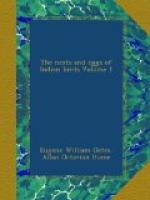Mr. T. Fulton Bourdillon, speaking of this Grackle in Travancore, says:—“This bird lays one or two light blue eggs beautifully blotched with purple in the holes of trees. It does not like heavy jungle, but after a clearing has been felled and burnt it is sure to appear. During the fine weather it is very abundant on the hills, descending to the low country at the foot when the rains have fairly set in. The nest scarcely deserves the name, being only a few dead leaves or some powdered wood at the bottom of the hole, and there about the end of March the egg or eggs are laid. The young birds, which can be taught to speak and become very tame, are often taken by the natives, as they can sell them in the low country. I have obtained on the following dates eggs and young birds:—
“March 29th. One egg slightly set.
April 20th. Two young birds.
April 22nd. " "
April 25th. Two eggs slightly set.
May 2nd. One young bird.
“I also had three eggs, slightly set, brought me on May 21. They are rather smaller and a deeper blue than the ones obtained before, being 1.25 x 1, 1.19 x .95, 1.21 x .97 inch. They were all out of the same nest, so that the bird sometimes lays three eggs, though the usual number is two.”
Colonel Legge writes in the ’Birds of Ceylon’:—“The Black Myna was breeding in the Pasdun Korale on the occasion of a visit I made to that part in August, but I did not procure its eggs.”
Other eggs subsequently sent me by Mr. Bourdillon from Mynall, in Southern Travancore, taken on the 9th and 13th April, 1875, are precisely similar to those already described. The eggs that I have measured have only varied from 1.22 to 1.37 in length, and from 0.86 to 0.9 in width.
524. Eulabes intermedia[A] (A. Hay). The Indian Grackle.
[Footnote A: Mr. Hume does not recognize E. javanensis and E. intermedia as distinct. The following account refers to the nidification of the latter, except perhaps Major Bingham’s later note, in which he states that he procured two distinct sizes of eggs in the Meplay valley (Thoungyeen). It is very probable that Major Bingham found the nests of both species on this occasion. I have seen no specimen of E. javanensis from the Thoungyeen valley, but at Malewun, further south, it occurs along with E. intermedia.—ED.]
Eulabes intermedia (A. Hay), Jerd. B. Ind. ii, p. 339. Eulabes javanensis (Osbeck), Hume, Rough Draft N. & E. no. 693.
The Indian Grackle, under which name I include E. andamanensis, Tytler, breeds, I know, in the Nepal Terai and in the Kumaon Bhabur; and many are the young birds that I have seen extracted by the natives out of holes, high up in large trees, in the old anti-mutiny days when we used to go tiger-shooting in these grand jungles. I never saw the eggs however, which, I think, must have all been hatched off in May, when we used to be out.




